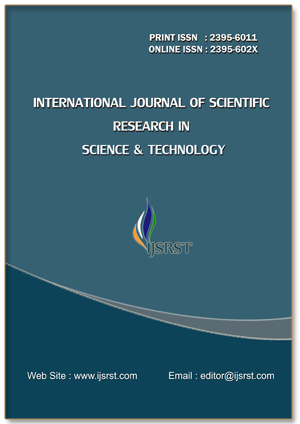Biofilm Formation and pH Indication: Exploring the Potential of Anthocyanin Extracted from Grape Skin
DOI:
https://doi.org/10.32628/IJSRST2512392Keywords:
biofilm, anthocyanin, pH-indicator, sodium alginate, total anthocyanin content (TAC)Abstract
This study developed a biopolymer-based pH-sensitive biofilm using sodium alginate, starch, calcium chloride, and anthocyanin extracted from black grapes skin. Total Anthocyanin Content (TAC) was measured using a pH differential method, and UV-Vis spectrophotometry assessed anthocyanin response across pH levels 1-14. The biofilm's stability was evaluated via moisture content analysis (initial weight: 120 g; dry weight: 22 g), water resistance, and long-term storage. The biofilm showed strong stability and pH sensitivity, displaying various colours across pH levels, from red at pH 1 to yellow-green at pH 14. Water resistance testing revealed minor anthocyanin leaching over 24 hours due to hydrophilic properties of starch. These findings suggest that this biofilm could serve as an eco-friendly pH indicator with potential applications in intelligent packaging.
📊 Article Downloads
References
A., N., N., N. S., A., N., & H., N. H. (2018). Total anthocyanin content and antioxidant activities of pigmented black rice (oryza sativa l. japonica) subjected to soaking and boiling. Jurnal Teknologi, 80(3). https://doi.org/10.11113/jt.v80.11135.
Kossyvaki, D., Contardi, M., Athanassiou, A., & Fragouli, D. (2022). Colorimetric Indicators Based on Anthocyanin Polymer Composites: A Review. Polymers, 14(19), 4129. https://doi.org/10.3390/polym14194129.
Roy, S., & Rhim, J.-W. (2021). Anthocyanin food colorant and its application in pH-responsive color change indicator films. Critical Reviews in Food Science and Nutrition, 61(14), 2297–2325. https://doi.org/10.1080/10408398.2020.1776211.
Zhao, L., Liu, Y., Zhao, L., & Wang, Y. (2022). Anthocyanin-based pH-sensitive smart packaging films for monitoring food freshness. Journal of Agriculture and Food Research, 9, 100340. https://doi.org/10.1016/j.jafr.2022.100340.
Zia, J., Mancini, G., Bustreo, M., Zych, A., Donno, R., Athanassiou, A., & Fragouli, D. (2021). Porous pH natural indicators for acidic and basic vapor sensing. Chemical Engineering Journal, 403, 126373. https://doi.org/10.1016/j.cej.2020.126373.
Contardi, M., Ayyoub, A. M. M., Summa, M., Kossyvaki, D., Fadda, M., Liessi, N., Armirotti, A., Fragouli, D., Bertorelli, R., & Athanassiou, A. (2022). Self-Adhesive and Antioxidant Poly(vinylpyrrolidone)/Alginate-Based Bilayer Films Loaded with Malva sylvestris Extracts as Potential Skin Dressings. ACS Applied Bio Materials, 5(6), 2880–2893. https://doi.org/10.1021/acsabm.2c00254.
Chumee, J., Kumpun, S., Nimanong, N., Banditaubol, N., & Ohama, P. (2022). Colorimetric biofilm sensor with anthocyanin for monitoring fresh pork spoilage. Materials Today: Proceedings, 65, 2467–2472. https://doi.org/10.1016/j.matpr.2022.07.103.
Erna, K. H., Felicia, W. X. L., Vonnie, J. M., Rovina, K., Yin, K. W., & Nur’Aqilah, M. N. (2022). Synthesis and Physicochemical Characterization of Polymer Film-Based Anthocyanin and Starch. Biosensors, 12(4), 211. https://doi.org/10.3390/bios1204021.
Ayu, A. C., Ida, M., Moelyono, M., & Fakhriati, S. G. (2018). Total Anthocyanin Content and Identification of Anthocyanidin from Plectranthus Scutellarioides (L.) R. Br Leaves. Research Journal of Chemistry and Environment.
Kowalczyk, T., Muskała, M., Merecz-Sadowska, A., Sikora, J., Picot, L., & Sitarek, P. (2024). Anti-Inflammatory and Anticancer Effects of Anthocyanins in In Vitro and In Vivo Studies. Antioxidants, 13(9), 1143. https://doi.org/10.3390/antiox13091143
Abdul Khalil, H. P. S., Banerjee, A., Saurabh, C. K., Tye, Y. Y., Suriani, A. B., Mohamed, A., Karim, A. A., Rizal, S., & Paridah, M. T. (2018). Biodegradable Films for Fruits and Vegetables Packaging Application: Preparation and Properties. Food Engineering Reviews, 10(3), 139–153. https://doi.org/10.1007/s12393-018-9180-3.
Metha, C., Pawar, S., & Suvarna, V. (2024). Recent advancements in alginate-based films for active food packaging applications. Sustainable Food Technology, 2(5), 1246–1265. https://doi.org/10.1039/D3FB00216K
Teng, Z., Jiang, X., He, F., & Bai, W. (2020). Qualitative and Quantitative Methods to Evaluate Anthocyanins. eFood, 1(5), 339–346. https://doi.org/10.2991/efood.k.200909.001
Krishnamurthy, A., & Amritkumar, P. (2019). Synthesis and characterization of eco-friendly bioplastic from low-cost plant resources. SN Applied Sciences, 1(11), 1432. https://doi.org/10.1007/s42452-019-1460-x
Amr, A., Jaradat, S., AlKhatib, H., Hamadneh, I., Hamadneh, L., Hodali, H., Zeadeh, M., & Shahein, M. (2022). Extraction of Anthocyanins from Black Grape By-Products and Improving Their Stability Using Cobalt(II) Complexation. Preventive Nutrition and Food Science, 27(4), 457–463. https://doi.org/10.3746/pnf.2022.27.4.457.
Alshamar, H. A., & Dapson, R. W. (2021). Anthocyanins from a single botanical source can be used as a replacement for hemalum and eosin. Biotechnic & Histochemistry, 96(8), 570–578. https://doi.org/10.1080/10520295.2021.1966507.
Dewi, R. R., Syahbanu, I., & Rahmalia, W. (2024). Senggani fruit (Melastoma malabathricum Linn.) extract as a natural indicator in pH-responsive PVA-taro starch plastic packaging. Turkish Journal of Chemistry, 48(3), 459–469. https://doi.org/10.55730/1300-0527.3672.
Downloads
Published
Issue
Section
License
Copyright (c) 2025 International Journal of Scientific Research in Science and Technology

This work is licensed under a Creative Commons Attribution 4.0 International License.
https://creativecommons.org/licenses/by/4.0




